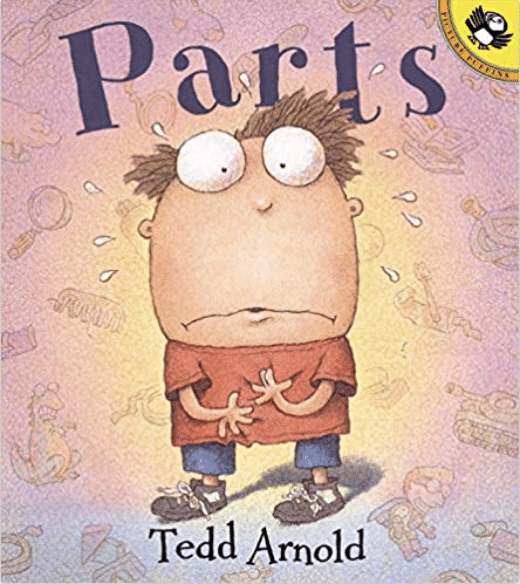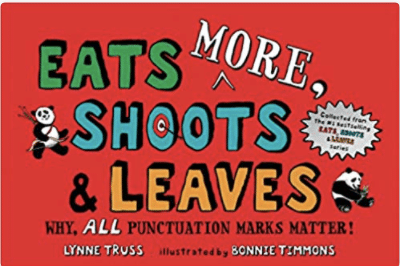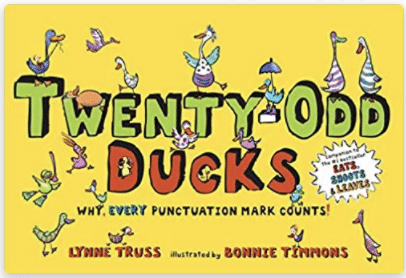Let’s Eat Grandma!
What??!
So, so sorry, dear reader. Please pardon my mistake. I wasn’t actually suggesting we eat kind, loveable, sweet grandma! I just meant to say that it was dinnertime. Let’s eat, Grandma!
Just the other day, the same kind of thing happened. As I passed the grocery store, I saw a sign that read, “We could sure use twenty-five dollar bills.” I did a double take. It should have read twenty five-dollar bills. 🙂
Though improperly punctuated examples like these may provide momentary laughs, that humor can quickly turn to awkwardness when they appear in student writing. 21st century standards for excellence demand better—so much better. Not only are students called to communicate ideas with supporting evidence and vivid details, but they must also use punctuation in ways that both enhance and properly frame those ideas.
So, what’s the problem? Well, to be frank, grammar and punctuation aren’t the literary equivalents to unicorns and daisies are they? Not all students (or teachers for that matter) enjoy learning about commas, periods, hyphens, exclamation marks, and semi-colons. Sure, comparing periods to stop signs or commas to yield signs is fairly simple. But what about the rest?
Here’s the not-so-secret solution.
Make punctuation FUN by using these rich, mentor texts. They’re packed with a diverse array of poetry, activities, humor and storytelling that will engage and delight students. These master writers share ‘punctulicious’ insights that will grab students’ attention and send them on their own journey to discovering the proper, purposeful, and powerful world of punctuation.
So, weep, no more people. Uh oh, I did it again. Weep no more, people.
See, proper punctuation pays off!
Loose teeth, boogers, and belly button fuzz have this little boy convinced that his parts are coming unglued. This comical mentor text follows a young boy and his discoveries of his growing body! This fun read-along picture book is intriguing for young readers and serves as a great lesson in grammar by utilizing a wide array of punctuation marks.
Types of punctuation: Hyphens, exclamation points, apostrophes, commas, question marks, and periods.
Eats, Shoots & Leaves by Lynne Truss
Using exciting and immersive illustrations, this mentor text shows students the importance of commas! The illustrations display the impact of misplaced or missing commas from sentences, emphasizing their use and impact on the meaning of sentences.
Types of punctuation: Commas (emphasis), quotations, question marks, periods.
Eats MORE, Shoots & Leaves: Why ALL Punctuation Marks Matter! By Lynne Truss
This mentor text demonstrates the importance of carefully placed punctuation marks and how much the meaning of a sentence relies on correct punctuation! Colorful pictures clearly illustrate the differences between carefully and recklessly placed punctuation marks for young readers.
Punctuation marks: Hyphens, periods, question marks, quotations, exclamation points, parentheses, commas, and apostrophes.
Yo! Yes? By Chris Raschka
This read is a perfectly simplistic mentor text for teaching young students about punctuation. The meeting of two kids on a street launches a story that celebrates differences and the important role of words to overcome them.
Punctuation marks: Question marks, periods, and exclamation points
Teacher Tip: Construct and distribute ‘punctuation stick signs’ to your students: periods, exclamation marks, and question marks. Read sentences aloud to your students and ask them to hold up the correct ending punctuation mark to complete the sentences!
The Girl’s Like Spaghetti: Why You Can’t Manage without Apostrophes!” by Lynne Truss
This mentor text makes punctuation lessons lovable! Apostrophes are made simple with colorfully illustrated pictures to show readers how important these marks are in making words possessive or plural.
Punctuation marks: Apostrophes and periods
Punctuation Takes a Vacation by Robin Pulver
All of the punctuation marks in Mr. Wright’s classroom leave to go on vacation in this mentor text. The non-punctuated books are chaotic and the students’ letters to the punctuation marks are a complete mess! This mentor text helps readers to understand the hard work that punctuation marks do for us with brightly colored illustrations and an action-packed storyline.
Punctuation marks: Quotation marks, question marks, commas, exclamation points, apostrophes, colons, and periods.
A Bunch of Punctuation by Lee Bennett Hopkins
A Bunch of Punctuation makes learning fun with a collection of short poems written from the perspective of punctuation marks with big personalities. This humorous mentor text makes the different functions of punctuation marks really easy to learn and remember. The witty poems and illustrations will add some fun to your grammar lesson, while also driving home the connections between punctuation marks and their uses.
Punctuation marks: Commas, apostrophes, periods, hyphens, parentheses, colons, exclamation points, question marks, quotations, and semicolons
Teacher Tip: Have students cut out different punctuation marks and then fill up the inside of the cut-outs with definitions and examples of how they’re used! It’s a fun activity for students and will make for great wall decorations.
Punctuation Celebration by Elsa Knight Bruno
This mentor text has fourteen quirky poems that will bring punctuation marks to life for students. The punctuation marks each have specific scenarios to help students make connections, like the comma that helps a train slow down, or the quotation marks that instruct people on what to do.
Punctuation marks: Commas, periods, quotation marks, colons, exclamation points, hyphens.
Teacher Tip: Get artsy with teaching punctuation by having students draw up new situations for the punctuation marks, like a balloon popping as an exclamation point!
If You Were an Apostrophe by Shelly Lyons
This mentor text focuses on apostrophes, first establishing their use in showing belongings and then progressing to illustrate their other uses. Colorful illustrations help make this picture book an excellent choice for teaching students the many different uses of the ‘confusing air comma’!
Punctuation marks: apostrophes
Teacher Tip: To reinforce the different ways to use apostrophes, create new sentences and distribute cut-out apostrophes for students to place. This exercise will help them to distinguish their different uses (possession, plurality, abbreviations, etc.)
Twenty-Odd Ducks: Why, every punctuation mark counts! By Lynne Truss
This mentor text plays with punctuation to teach students the importance of correctly placed punctuation! Goofy illustrations assist in showing how wonky sentences can become with mixed-up punctuation marks and make this book great fun for any grammar lesson.
Punctuation marks: Hyphens, parentheses, quotation marks, periods, commas, apostrophes, exclamation points
I hope you found some amazing books to use as mentor text for teaching punctuation! See more tips and resources below. Also for more suggested Mentor Text for Punctuation, CLICK HERE.
Read this blog for more tips on teaching punctuation.
Check out these resources:
-
INTERACTIVE STEP-BY-STEP® WRITING PROGRAM ULTIMATE BUNDLE
Original price was: $379.00.$189.00Current price is: $189.00.
Save this blog on Pinterest:


















